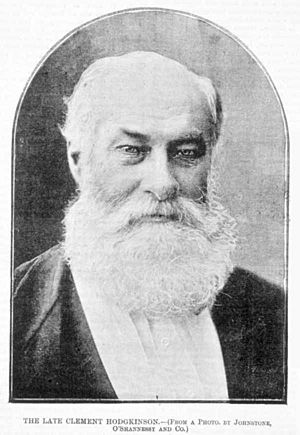Clement Hodgkinson facts for kids
Clement Hodgkinson (1818 – 5 September 1893) was an English naturalist, explorer, and surveyor. He explored many parts of Australia. He was a very important person in the early days of the Victorian colony. From 1861 to 1874, he worked as the Assistant Commissioner of Crown Lands and Survey. This meant he helped manage and map out the land for the government.
Contents
Exploring New South Wales
Clement Hodgkinson was trained as a civil engineer. He left England in 1839 to become a farmer in Australia. He bought a cattle farm near Kempsey, north of Sydney.
A year later, the government of New South Wales hired him. His job was to explore and map the northeastern parts of the colony. He traveled all the way to Moreton Bay. In March 1841, he explored the upper parts of the Nambucca and Bellinger rivers. He was the first European to meet the local Aboriginal people there.
He then followed several other river valleys. These included the Macleay, Clarence, Hastings, Richmond, and Tweed rivers. He also visited places like Port Macquarie, Brisbane, and Moreton Bay.
After his explorations, he went back to England. In 1845, he wrote a book about his travels. It was called Australia, from Port Macquarie to Moreton Bay. In his book, he wrote about the Aboriginal way of life. He also described the amazing nature he saw.
He wrote about the thick rainforests:
"...the unique look of the forest comes from countless types of climbing plants. These wild vines and strange plants are all tangled together. They weave through the trees almost to the top. They hang down like beautiful, flowing decorations from the highest branches. The rich and strong nature of these forests, especially on good soil in northern New South Wales, is as good as any tropical place. When this forest land is cleared and farmed, its richness seems endless..."
Hodgkinson also described the Bellinger River valley. He said it had "the finest cedar and rosewood I have ever seen." He noticed that local Aboriginal tribes strongly protected their land from people cutting down trees. Later, when Hodgkinson returned to the valley, some Yarrahappinni people went with him. They helped assure the locals that he had good intentions.
Designing Melbourne's Gardens
Hodgkinson must have enjoyed his first time in Australia. In the 1850s, he traveled from England to the young colony of Victoria again. He joined the Survey Office in 1852 as a draftsman. This meant he drew maps and plans. In 1855, he became the District Surveyor for Victoria. As part of his work, he helped plan the town of Warrandyte in 1856. From 1857 to 1858, he was the Surveyor General of Victoria. This was a very important role in mapping the colony.
Clement Hodgkinson played a huge part in designing Melbourne's beautiful parks and gardens. In 1860, he became the head of the Lands Department. He took a great interest in planning the city's green spaces.
Some of the famous gardens he helped design include:
- He made a plan in 1862 for the Flagstaff Gardens.
- He designed and oversaw the creation of the Fitzroy Gardens.
- Queen Victoria gave land in 1865 for the Edinburgh Gardens. Hodgkinson then laid out these gardens in North Fitzroy.
- He designed the Treasury Gardens in 1867. He made the paths cross diagonally, like the Union Jack flag. Willow trees were planted around a pretty pond.
- He was given the job of designing the St Kilda recreational area. Today, this is known as Alma Park.
- He made some small changes to the Carlton Gardens. These gardens are now a World Heritage Site. He worked with others to design areas cleared after big exhibitions.
- He also helped design Princes Park in Maryborough. He worked with other important landscape designers, William Guilfoyle and Hugh Linaker.
In 1873, Hodgkinson became the Inspector General of Metropolitan Parks and Reserves. He retired a year later. Even in retirement, he continued to work on landscapes. He designed parts of the Melbourne General Cemetery. In 1882, he joined a committee to inspect the city gardens he had helped create.
Managing Victoria's Forests
In his last years as Assistant-Commissioner, Hodgkinson started a program to protect Victoria's forests. He wanted to control how people used the forests. He helped set up the Central Forest Board in 1874. This board looked after the whole forest system. Hodgkinson was a member of this board. He retired from public service shortly after.
Royal Society of Victoria
Hodgkinson was also involved with the Royal Society of Victoria. This group discussed science and gave advice to the government. He wrote papers on topics like the good soil in Victoria for growing crops and grapes. He also wrote about water measurement and the geology of the Upper Murray area.
One of his most important contributions was arguing for using Australian rainfall and evaporation calculations. This helped decide where to build Melbourne's first big water reservoir, called Yan Yean.
Hodgkinson was a Vice-President of the Philosophical Institute of Victoria in 1856 and 1858. He was also a Council Member of the Royal Society of Victoria from 1859 to 1860. In 1860, he was part of the Royal Society's Exploration Committee. This committee helped organize the famous Burke and Wills expedition.
Tributes
A plant called Hodgkinsonia ovatiflora was named after Clement Hodgkinson. It is also known as Hodgkinsonia or Golden ash. This plant grows in rainforests from the Hastings River in New South Wales to Mackay in Queensland.
In 1858, a man named John Hardy named Olinda creek after Alice Olinda Hodgkinson. She was Clement Hodgkinson's daughter. Later, the suburb of Olinda was named after this creek.


